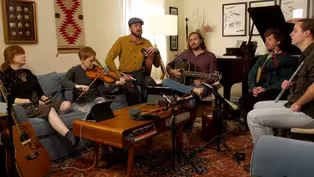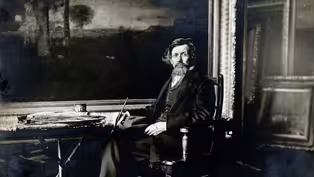State of the Arts
Layqa
Clip: Season 41 Episode 5 | 8m 47sVideo has Closed Captions
Ecuadorian artist Layqa Njna Yawar creates a mural at Newark Airport
To celebrate the opening of a new terminal, Newark Airport teamed up with the Public Art Fund and the Port Authority on one of the largest public arts projects since the days of Roosevelt. Among the new works is a colossal mural from Newark-based Indigenous Ecuadorian artist Layqa Nuna Yawar.
Problems playing video? | Closed Captioning Feedback
Problems playing video? | Closed Captioning Feedback
State of the Arts is a local public television program presented by NJ PBS
State of the Arts
Layqa
Clip: Season 41 Episode 5 | 8m 47sVideo has Closed Captions
To celebrate the opening of a new terminal, Newark Airport teamed up with the Public Art Fund and the Port Authority on one of the largest public arts projects since the days of Roosevelt. Among the new works is a colossal mural from Newark-based Indigenous Ecuadorian artist Layqa Nuna Yawar.
Problems playing video? | Closed Captioning Feedback
How to Watch State of the Arts
State of the Arts is available to stream on pbs.org and the free PBS App, available on iPhone, Apple TV, Android TV, Android smartphones, Amazon Fire TV, Amazon Fire Tablet, Roku, Samsung Smart TV, and Vizio.
Providing Support for PBS.org
Learn Moreabout PBS online sponsorship[ Plane engines whining ] [ Tender tune plays ] Nuna Yawar: An airport is like a blank canvas, in a way.
It's the first thing that millions of people see when they land to a country.
It's an introduction to a land, a people, a history.
How we approach that introduction is important.
[ Camera shutter clicking ] [ Keys jingling ] For this project, it is very interesting that I'm part of that introduction because I could argue that I'm not a person that belongs in here.
I left Ecuador when I was 14.
My whole family tried to find a better place to live or a way to move forward socially, so they migrated.
I spend a lot of time thinking about what that meant.
Like why did my family leave or who am I because of that?
So, I think it's an interesting [indistinct] and a beautiful engine for the future, to be an immigrant, to create home, to carry home with you, and to really expand the idea of what home is and what belonging means.
[ Poignant tune plays ] I think, as an artist, it is my sort of duty to learn from this land.
I am also thinking about large-scale public works and how they challenge or change a place.
And, somehow, that's what the airport needed and what they were asking for.
[ Bright tune plays ] They were looking for a mural that would reflect what it means to be from here.
Woman: There's almost never any representation of actual workers in their places.
Nuna Yawar: My process started with research and spending some time at the airport, just having conversations with people.
Woman #2: My original country is from Peru, from Lima.
Nuna Yawar: The collaboration itself, it was important to me.
Woman #2: My job is on call.
If somebody try to breach a door, I respond by the radio.
Walela: Good morning, ma'am.
You need a wheelchair?
How's your morning?
Walela: It's good.
Nuna Yawar: I think a lot of the figures that populate my work are a lot of the figures that I see in my everyday.
You know, maybe some people would say not important people and that's what I think makes them important.
That's why it makes me want to celebrate them.
Walela: When you say you're from Newark, people give you this look, like a negative vibe.
Nuna Yawar: Mm.
Walela: I wanted to let people know that Newark is alive and thriving.
Nuna Yawar: Sort of like this?
Walela: Like this?
Nuna Yawar: Yeah.
[ Camera shutter clicks ] [ Click ] I think there's a really beautiful dance that happens in public art when we think about who gets to be represented, who gets to be remembered, made into a huge mural.
I didn't want to sort of try to reflect icons and iconography that are known or established for New Jersey.
I wanted to make new ones.
I'm focusing on labor.
I'm focusing on just everyday, you and me, people because this is a mirror of the land.
This is a mirror of its very contentious history, of it's reality of the people that are living here.
I think the best thing that I could do with my work is to sort of amplify those narratives.
Because that's how we learn and that's how we push things forward.
[ Bright hip hop plays ] [ Bright hip hop plays ] [ Bright hip hop plays ] [ Bright hip hop plays ] [ Bright hip hop plays ] [ Beeping ] So, basically, I'm going to move from that edge all the way down here, just cutting [indistinct].
And then I should be done.
Man: Alright.
Do what you got to do Nuna Yawar: [Indistinct] Man: and then we'll talk and then I'll [indistinct] yeah.
[Indistinct] Somebody dropped some paint on a [ Voice fades ] [ Whirring ] [ Whirring ] Nuna Yawar: This amplification of someone's identity or personhood is sometimes the most powerful thing you could ever do.
To me, it's not political.
To me, it's just a celebration, right?
The political happens when it becomes public, when other people look at something and then they have a different opinion of what this is.
[ Whirring ] My job, as an artist, is to be challenging.
Challenge the question of what represents New Jersey.
Any sort of reaction that comes from that...
...I welcome it as a point of conversation.
[ Tender tune plays ] [ Tender tune plays ] [ Tender tune plays ] Man: Yeah.
Nuna Yawar: I hope people see themselves when they see this mural.
I think like all artists' work helps us better understand ourselves and what identity means.
Like understanding and accepting myself as a person that doesn't have to be divided.
Understand that I do belong to this country, as much as to the one that came before.
Woman #3: See?
This is her!
Right there!
Woman #2: Hi!
Hello!
Walela: The hummingbird, which is my part Native American roots and my given name, Walela.
Woman #2: And then, you know, getting all the like -- like getting a flower, like, you know, you growing.
Walela: Mm-hmm.
Woman #2: But for me, I see the people like that, where you growing.
Yawar: What would I like to have seen when I landed in the USA?
Maybe I would've felt differently, seeing this.
Maybe I would've felt held and understood.
You know, maybe now, other people will.
[ Tender tune plays ]
Video has Closed Captions
Clip: S41 Ep5 | 7m 9s | The Princeton-based Chivalrous Crickets blend Celtic, English, and American folk music (7m 9s)
The Montclair Art Museum's George Inness Gallery
Video has Closed Captions
Clip: S41 Ep5 | 6m 45s | The unique, chapel-like George Inness Gallery at the Montclair Art Museum (6m 45s)
Providing Support for PBS.org
Learn Moreabout PBS online sponsorshipSupport for PBS provided by:
State of the Arts is a local public television program presented by NJ PBS

















